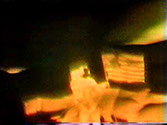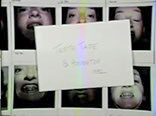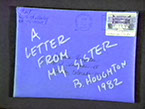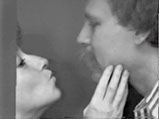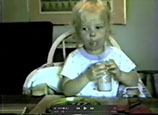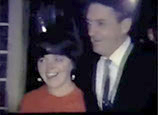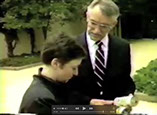VIDEOTAPES AND VIDEO PERFORMANCES
The Star Spangled Banner 1982: My first video: no editing, one take. I projected a slide of Neil Armstrong with a flag on the surface of the moon onto my hand which I moved and bent my fingers to make the flag wave.
Teeth Tape 1982: I had no editing equipment so I “edited” in camera. The first layer of the image was shot of my SX70 teeth images one at a time pausing between each shot to change the picture. Then that video was played on the monitor that had one of the SX70s taped to the surface in front of the video and rerecorded. I adjusted the monitor to do the “processing” of the image to make the resulting video more interesting. I used music and the sound of a bolt being driven into a piece of wood by a racket to simulate the sound I heard in my head when my teeth were moving after my braces were tightened.
A Letter from My Sister 1982: A reading of the letter about the birth of my niece Nicole with images laying over the letter. Made from still images.
A Love's Dilemma 1984: A slow-scan video performance piece. With video cameras in two separate places, she reaches for him, he goes away as the scan puts her image over his. When he reaches for her the same thing happens. When they are ready to kiss, the scan moves across the screen and wipes her out before their lips meet. The sound is messages from a telephone answering machine that hints at the missed opportunities.
A Book of Family Tales 1987: As part of a sculptural stage, three stories are told.
1. Joyce and Nicole: Joyce tells how she could not stand to watch her baby daughter eat and get food all over herself. 2. Mom Mooning: Three versions of her daughters telling the story of mom mooning them while riding in a car, then telling them it's got to be a secret from Dad and their brothers. 3. The Inheritance: I go to the bank to collect our inheritance from our father and the bank turns out to be the can bank and the inheritance turns out to be a station wagon filled with beer cans.
From my earliest work, I sought to tell the story of who I was and how I observed the world around me. While mostly working as a photographer, my work often followed whatever media was needed to tell the story.
Most of the time the video work was not freestanding to be shown in a darkened room with a seated audience. Instead, it was part of a larger idea project where sculptural and photographic elements filled out the story. If you look at the installation page, you will see other places where I incorporated video into the pieces.
For me, video has filled in where I needed more information, or was the only way for me to tell the story. For the slow-scan video performance, where we had use of the equipment for a day or two, the idea came from some personal relationship issues and I convinced my friend Roger Lang to act it out with me. Because of the short time with the equipment, we recorded the performance twice and then the equipment had to be returned.
In 1984, I spent a semester on sabbatical at my graduate school, The School of the Art Institute of Chicago, learning how to edit videotape. When I got back home, I sold my house and bought a new place with studio space and used part of the money for video editing equipment, a computer, scanner and was frustrated because technology had not caught up with my ideas. It seemed that I was always wanting more than could be delivered from the equipment I had. However, when re-looking at these, I feel the ideas were solid and probably ahead of their making.
https://en.wikipedia.org/wiki/Slow-scan_television
Slow Scan television (SSTV) is a picture transmission method used mainly by amateur radio operators, to transmit and receive static pictures via radio in monochrome or color.
A literal term for SSTV is narrowband television. Analog broadcast television requires at least 6 MHz wide channels, because it transmits 25 or 30 picture frames per second (in the NTSC, PAL or SECAM color systems), but SSTV usually only takes up to a maximum of 3 kHz of bandwidth. It is a much slower method of still picture transmission, usually taking from about eight seconds to a couple of minutes, depending on the mode used, to transmit one image frame.
Since SSTV systems operate on voice frequencies, amateurs use it on shortwave (also known as HF by amateur radio operators), VHF and UHF radio.
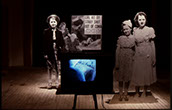
Miracle Girl 1987: An installation with a video performance showing on the monitor set on a stool in the installation of large cut out photographs. The performance is the young girl walking through the same installation while drying a dish. Then the girl sits and looks through a scrapbook. The story is about my mother who got shot in the head when she was 13 while drying dishes in her kitchen on the west side of Chicago in 1938. The girl is my 13 year old sister who looked quite a lot like our mother.
barbara@barbarahoughtonphoto.com all contents © barbara houghton 2022
